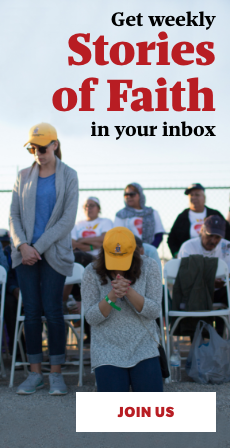Artificial intelligence is for many a chilling technological revolution that has arrived at our doorstep. The notion that a robot can exceptionally mimic human intelligence is something that keeps many people up at night.
Artificial intelligence has, in fact, been around for almost 70 years. The term “AI” was actually born in 1956 through the emergence of cybernetics— the science of control in machines and humans. In the last 15 years, AI has progressed further thanks to massive data and new computing power. Many people are already familiar with the newest crop of AI tools like ChatGPT, which was launched in late 2022.
As with any technological innovation, it has the potential to be used for good or evil, just like those that came before it. The cotton gin sped up textile production, but also prolonged the institution of slavery in the U.S. The industrial revolution created cheaper and more accessible goods, but also led to dangerous work conditions, greater pollution and child labor. Social media’s debut allowed us to connect with old friends, but also gave way to easier dissemination of hate and disinformation.
Many people feel that we are on the brink of perhaps another even greater revolution with the dawn of AI. In his January 1 message to the world, Pope Francis expressed a mix of sentiments: openness to this latest technology with a heavy dose of caution.
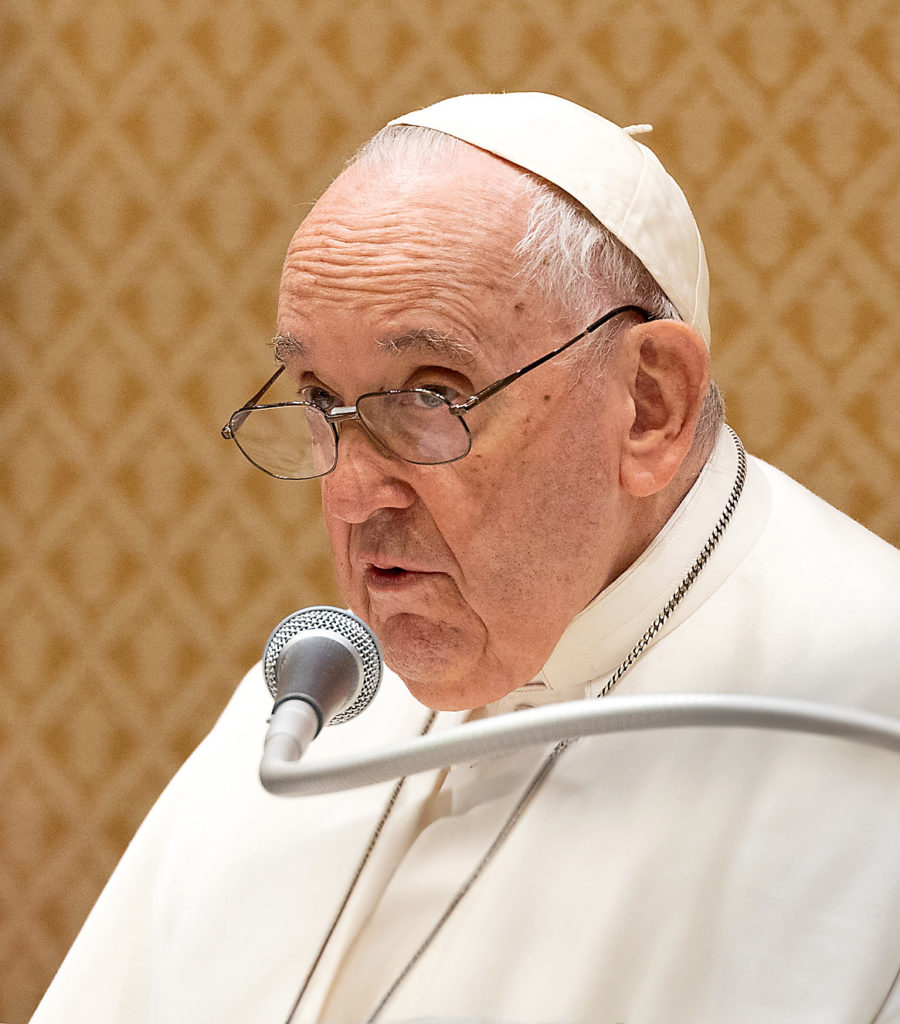
He warned against any use of technology that would distort reality; be used as a weapon of war; or in any way become detrimental to the well-being of the poor, the innocent and the young.
“We rightly rejoice and give thanks for the impressive achievements of science and technology, as a result of which countless ills that formerly plagued human life and caused great suffering have been remedied,” said Pope Francis. “At the same time, techno-scientific advances, by making it possible to exercise hitherto unprecedented control over reality, are placing in human hands a vast array of options, including some that may pose a risk to our survival and endanger our common home.”
Upside of AI?
Some speculate that AI offers tremendous benefits. Could it lead to more medical breakthroughs, even finding the cure to cancer? The pope said, “If artificial intelligence were used to promote integral human development, it could introduce important innovations in agriculture, education and culture; an improved level of life for entire nations and people; and the growth of human fraternity.”
If we learn to use it appropriately and harness it ethically, AI could serve as an augmentation— and not a total replacement— of human intelligence. “Human” is the key word here. Humans must be the drivers of this technology. The technology should not drive us.
The cover of the Spring edition of Extension magazine, seen below, opens our minds to how we can come to understand AI and work to use it as a tool for good.
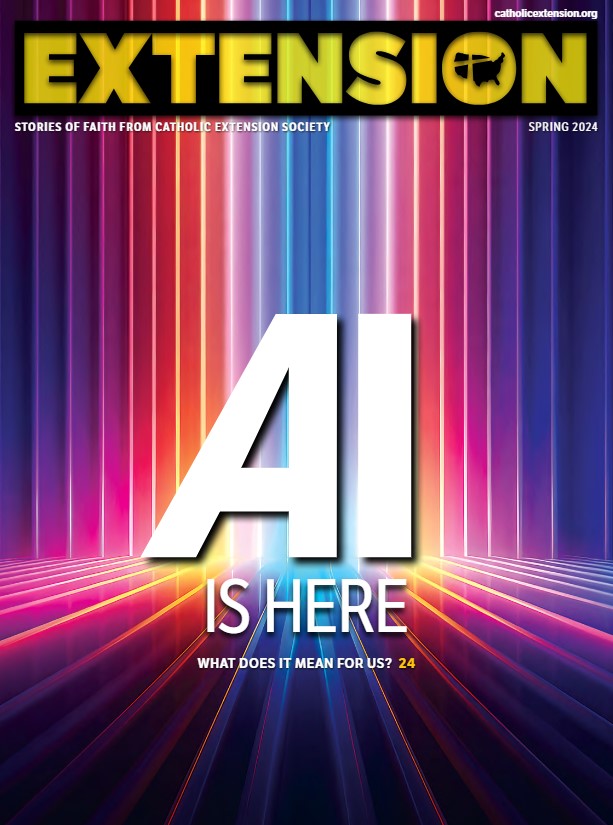
According to an Associated Press report, the definition of artificial intelligence hits these four areas: AI helps to process data, AI does not have a mind of its own, AI depends on data that humans feed it, and AI produces results from human-fed information.
Those last three points are essential in helping us understand artificial intelligence. AI is reliant on us human beings to tell it what we want to create. Based on our instruction, our own thought-out prompting based on our human knowledge, emotions and moral understanding, it will then attempt to create what we are thinking about.
As the drivers of this up-and-coming technology, humans must provide ethical guidance on using this tool. As Pope Francis mentioned in his message, “Freedom and peaceful coexistence are threatened whenever human beings yield to the temptation to selfishness, self-interest, the desire for profit and the thirst for power. We thus have a duty to broaden our gaze and to direct techno-scientific research towards the pursuit of peace and the common good, in the service of the integral development of individuals and communities.”
He continued,
Artificial intelligence ought to serve our best human potential and our highest aspirations, not compete with them.”
AI and our Catholic faith
Using this approach to AI, we at Catholic Extension Society wondered if this new technology could also assist as a tool in deepening our religious sensibilities and potentially serve as a tool of catechesis and evangelization.
To demonstrate this, we employed a new AI system, Midjourney, to create vivid religious art that speaks to our Catholic faith and traditions. The system responded to prompts based on Catholic theological ideas that we fed it regarding the lives of the saints, Catholic traditions and biblical moments.
See below how we prompted AI to create a realistic photo of the conversion of Saul as he is being blinded by a light from heaven on his way to Damascus, after which the former zealous persecutor of the Christian Church becomes St. Paul the Apostle.
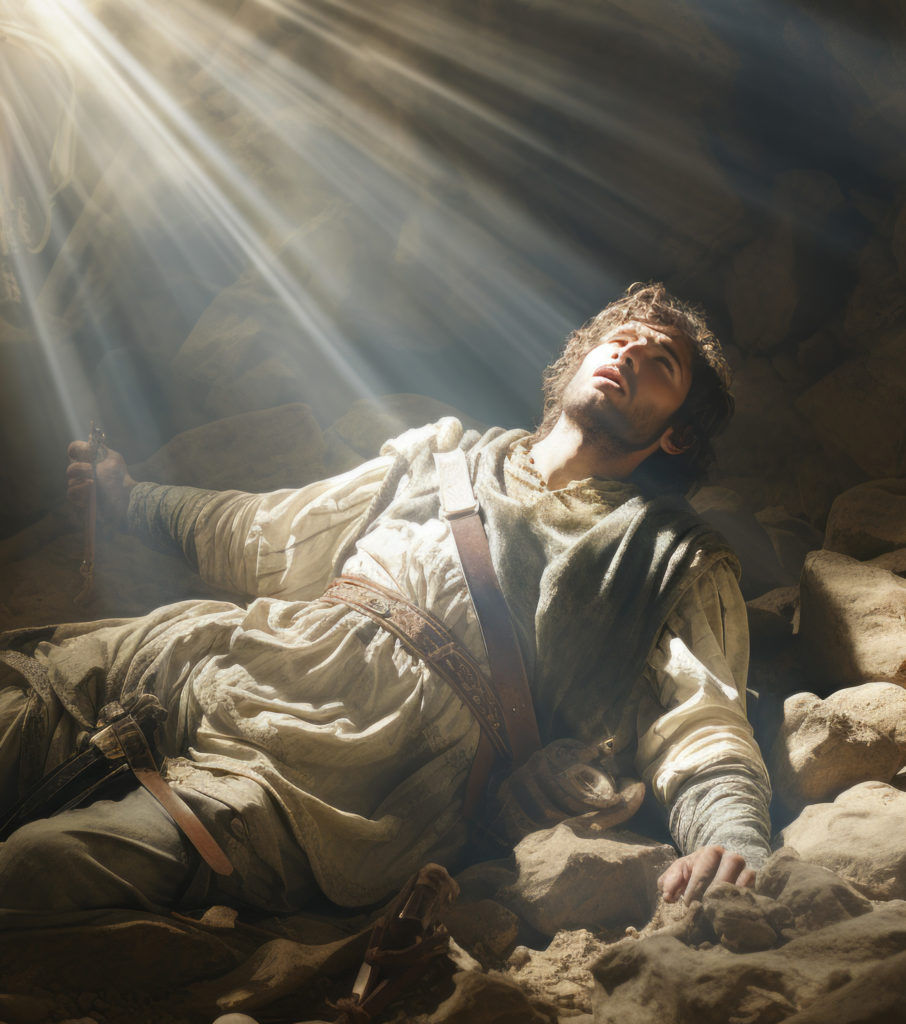
Speaking of traditions, Father Francis Clement Kelley established Catholic Extension Society in 1905 to bring the sacraments to remote faith communities across the country. The mission first spread by way of the railways, with priests riding into tiny frontier towns to celebrate Mass from the backs of rail cars.
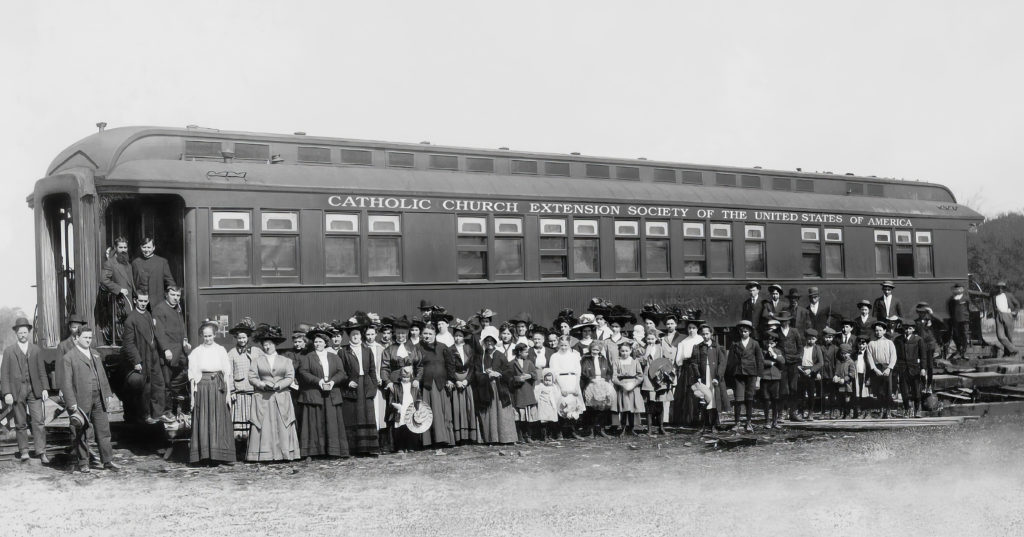
Inspired by our early history, we prompted artificial intelligence to create an image showing Catholic Extension Society’s chapel car pulling into a small Montana town for Mass to be celebrated with the people. We gave AI the original image of our chapel car, seen above, so it could compute what the rail car looked like, and how people in the early 1900s should be presented. Here below is the image generated by artificial intelligence. How do you think AI did re-creating this scene from the first days of Extension?

When prompting AI, one can ask for different features, concepts and certain variations. When we first prompted AI for the images in this story, we got fair returns, but not what we felt to be the most spiritually accurate portrayal. This is an important realization when working with AI. Humans must be able to recognize when AI makes something that isn’t quite right. AI does not comprehend errors in the same way humans do. So, we must then use our reasoning to guide AI in fixing the issue in order to create something that is theologically accurate and captivating.
Inclusive approach to AI
Pope Francis suggests that when considering how to use AI, we should include the voices of many stakeholders, including the poor. We took that approach in this AI experiment. For example, in including the voices of many, we sought help in generating an image of Our Lady of Guadalupe. We asked Latina Catholic leaders in Catholic Extension Society’s Mujer Valiente (“Valiant Woman”) program to weigh in on our initial images and how they believe Our Lady of Guadalupe should be depicted.
The women remarked that the initial image of Our Lady of Guadalupe, seen below, was beautiful, but it was inaccurate in that she lacked indigenous features— which are key to her apparition story.

As Blanca Primm, director of Hispanic ministry for the Diocese of Knoxville, Tennessee, said, “It invites me to pray and is very pretty too, although her appearance is not as mestiza (mixed ancestry).” The responses of the women, filled with love, joy, holiness, and creativity, led us to better prompting of the AI generator and the creation of this final image better capturing these indigenous features.

The leaders we asked are of varying ages, educational backgrounds and experiences. They share a deep love of the Catholic faith, have a desire to deepen that faith and are committed to sharing their faith with others.
These are the exact right agents for AI. They are an example of those people Pope Francis described who can properly show us how artificial intelligence can serve to create something good.
So, we want to know what you think: Can artificial intelligence help us more vividly tell the stories of our faith? You be the judge. Send us your thoughts on these images and this story at magazine@catholicextension.org.
